UTS Health: Language Developmental Delay and Impact Report
VerifiedAdded on 2023/01/18
|8
|1951
|67
Report
AI Summary
This report delves into the critical aspect of language development in children, highlighting its significance for healthy and normal lives. It explores the impacts of delayed language development, including behavioral problems, hearing impairments, and social difficulties. The report emphasizes the crucial role of Child and Family Health Nurses (CFHNs) in early detection and intervention. It details how CFHNs create supportive environments, design child-friendly interventions, and facilitate conversations to empower children, minimize the impact of delays, and support families. The report references relevant studies and resources, underscoring the importance of early intervention in promoting children's well-being.
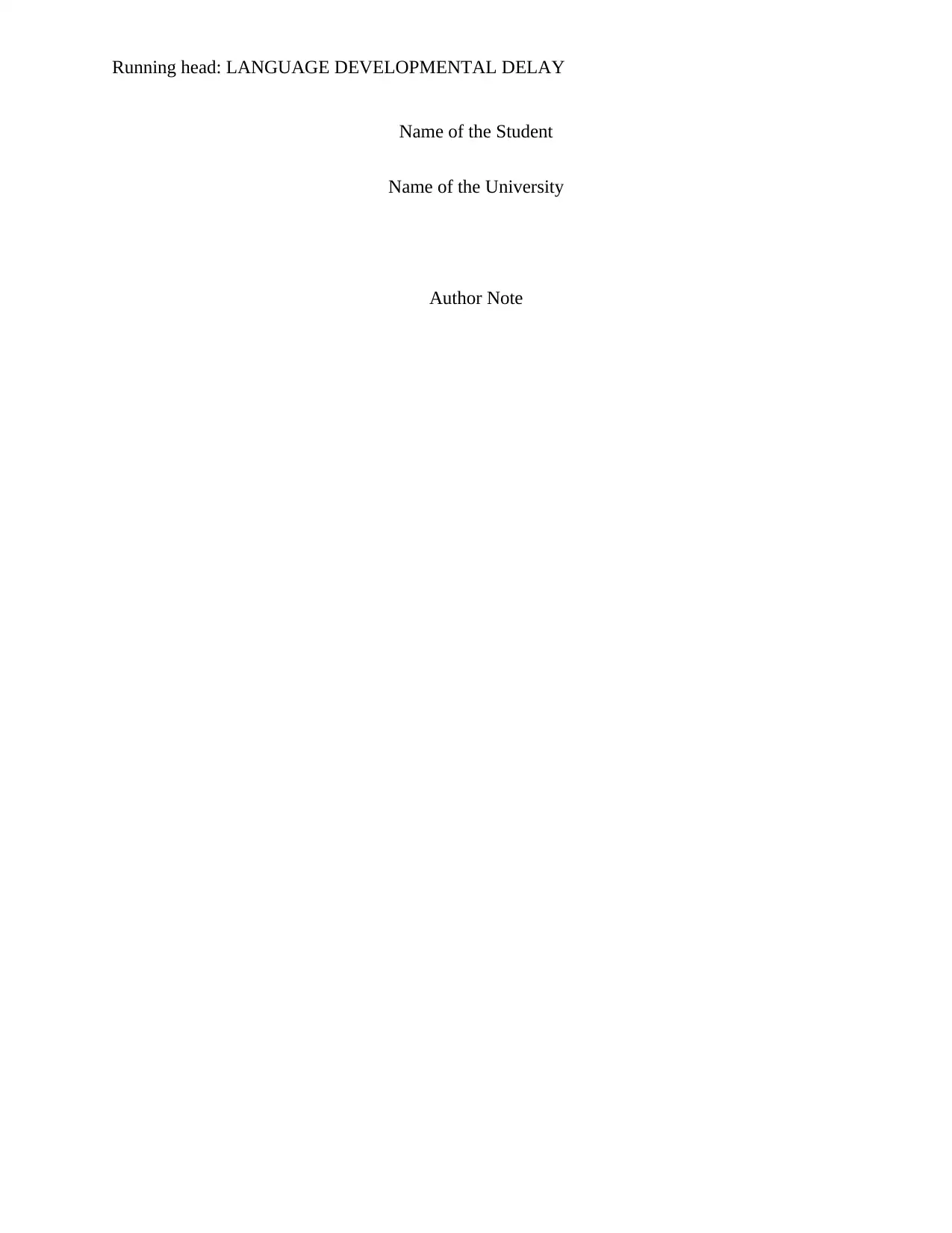
Running head: LANGUAGE DEVELOPMENTAL DELAY
Name of the Student
Name of the University
Author Note
Name of the Student
Name of the University
Author Note
Paraphrase This Document
Need a fresh take? Get an instant paraphrase of this document with our AI Paraphraser
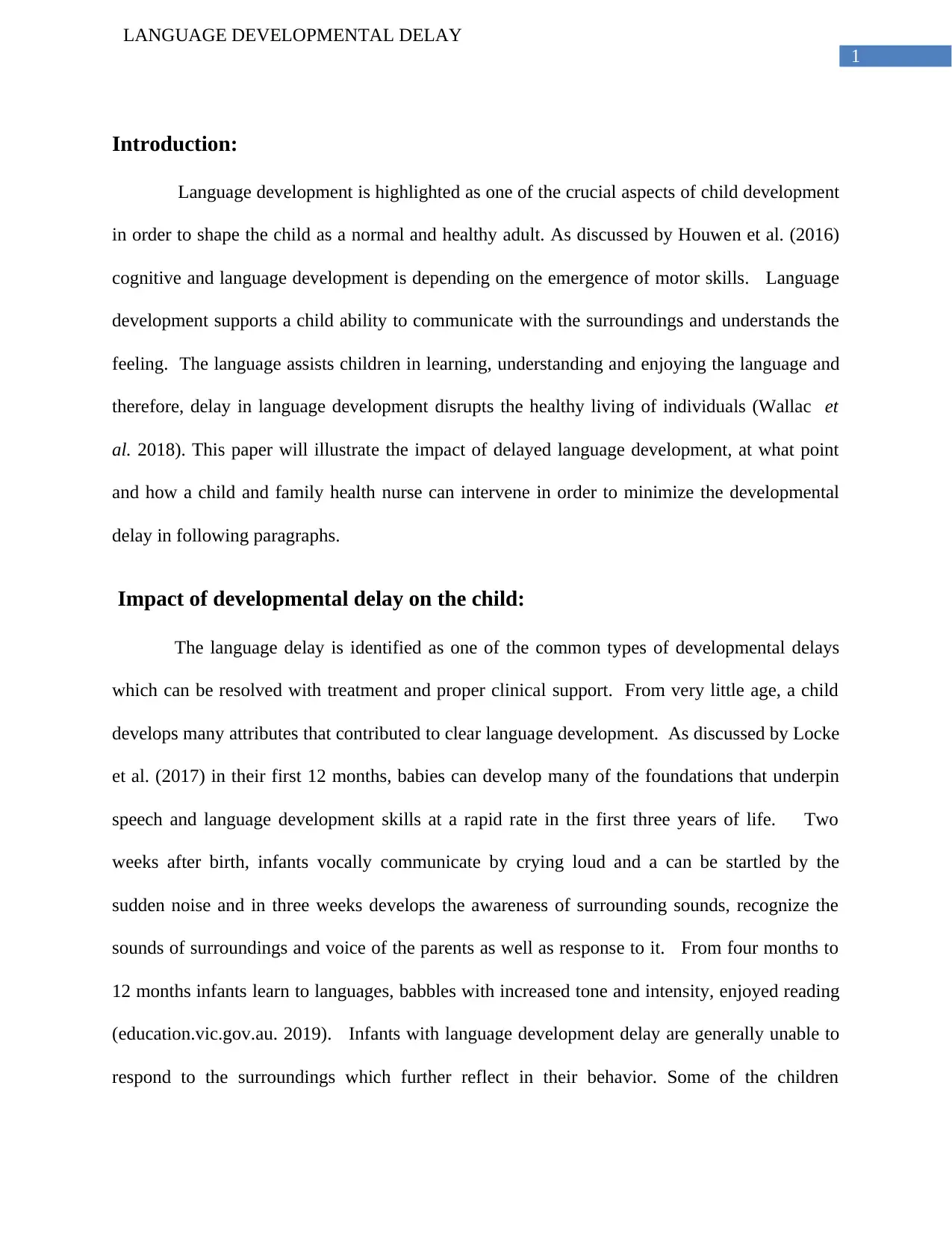
1
LANGUAGE DEVELOPMENTAL DELAY
Introduction:
Language development is highlighted as one of the crucial aspects of child development
in order to shape the child as a normal and healthy adult. As discussed by Houwen et al. (2016)
cognitive and language development is depending on the emergence of motor skills. Language
development supports a child ability to communicate with the surroundings and understands the
feeling. The language assists children in learning, understanding and enjoying the language and
therefore, delay in language development disrupts the healthy living of individuals (Wallac et
al. 2018). This paper will illustrate the impact of delayed language development, at what point
and how a child and family health nurse can intervene in order to minimize the developmental
delay in following paragraphs.
Impact of developmental delay on the child:
The language delay is identified as one of the common types of developmental delays
which can be resolved with treatment and proper clinical support. From very little age, a child
develops many attributes that contributed to clear language development. As discussed by Locke
et al. (2017) in their first 12 months, babies can develop many of the foundations that underpin
speech and language development skills at a rapid rate in the first three years of life. Two
weeks after birth, infants vocally communicate by crying loud and a can be startled by the
sudden noise and in three weeks develops the awareness of surrounding sounds, recognize the
sounds of surroundings and voice of the parents as well as response to it. From four months to
12 months infants learn to languages, babbles with increased tone and intensity, enjoyed reading
(education.vic.gov.au. 2019). Infants with language development delay are generally unable to
respond to the surroundings which further reflect in their behavior. Some of the children
LANGUAGE DEVELOPMENTAL DELAY
Introduction:
Language development is highlighted as one of the crucial aspects of child development
in order to shape the child as a normal and healthy adult. As discussed by Houwen et al. (2016)
cognitive and language development is depending on the emergence of motor skills. Language
development supports a child ability to communicate with the surroundings and understands the
feeling. The language assists children in learning, understanding and enjoying the language and
therefore, delay in language development disrupts the healthy living of individuals (Wallac et
al. 2018). This paper will illustrate the impact of delayed language development, at what point
and how a child and family health nurse can intervene in order to minimize the developmental
delay in following paragraphs.
Impact of developmental delay on the child:
The language delay is identified as one of the common types of developmental delays
which can be resolved with treatment and proper clinical support. From very little age, a child
develops many attributes that contributed to clear language development. As discussed by Locke
et al. (2017) in their first 12 months, babies can develop many of the foundations that underpin
speech and language development skills at a rapid rate in the first three years of life. Two
weeks after birth, infants vocally communicate by crying loud and a can be startled by the
sudden noise and in three weeks develops the awareness of surrounding sounds, recognize the
sounds of surroundings and voice of the parents as well as response to it. From four months to
12 months infants learn to languages, babbles with increased tone and intensity, enjoyed reading
(education.vic.gov.au. 2019). Infants with language development delay are generally unable to
respond to the surroundings which further reflect in their behavior. Some of the children

2
LANGUAGE DEVELOPMENTAL DELAY
behavioral problem such as anger, frequent crying, irritated refuse to eat because of the
frustration they experienced for the inability to express themselves. For the infant’s up to
6months, the inability to express can affect the social interaction with parents and also influence
the oral muscle tone such as the tongue, lips, and cheeks muscle (Song et al. 2016). The
children in-between 6 to 12 with delayed language development are unable to recognize sounds
rather sequence sound together. Children in-between 1 to 2 years shows frustration with the
expression of anger with lack of clarity in speech as well as difficulty in understanding the
speech of others (Raisingchildren.net.au 2019). Children in between 2 to 5 years with language
delay are unable to socialize in school because of the inability to express themselves within peer
groups. Those infants have difficulty to write proper spelling in schools because of articulation
errors (childdevelopment.com.au 2019). However, undetected language developmental delay is
associated with other physical and cognitive difficulties. As discussed by Geers et al. (2016),
delayed language development induces hearing loss since language developmental delay acts as
a warning sign of delayed cognitive development. The hearing loss is one of the common
sensory deficit experienced by children. Children may have difficulties in hearing words ending
with -s or –ed and difficulties in forming complex sentence structures (Veale et al. 2016). The
hearing loss often directly associated with difficulties in academic performance and social
isolations. Therefore, if the delayed language developments are detected early during birth
screening or within 1 to 2 years, many complications can be reduced with clinical assistance and
early interventions.
Child and family health nurse in language development:
The Child and family health nurses (CFHN ) are registered nurses who give free support
and information to families with children under six years. The nurses offer regular check up on
LANGUAGE DEVELOPMENTAL DELAY
behavioral problem such as anger, frequent crying, irritated refuse to eat because of the
frustration they experienced for the inability to express themselves. For the infant’s up to
6months, the inability to express can affect the social interaction with parents and also influence
the oral muscle tone such as the tongue, lips, and cheeks muscle (Song et al. 2016). The
children in-between 6 to 12 with delayed language development are unable to recognize sounds
rather sequence sound together. Children in-between 1 to 2 years shows frustration with the
expression of anger with lack of clarity in speech as well as difficulty in understanding the
speech of others (Raisingchildren.net.au 2019). Children in between 2 to 5 years with language
delay are unable to socialize in school because of the inability to express themselves within peer
groups. Those infants have difficulty to write proper spelling in schools because of articulation
errors (childdevelopment.com.au 2019). However, undetected language developmental delay is
associated with other physical and cognitive difficulties. As discussed by Geers et al. (2016),
delayed language development induces hearing loss since language developmental delay acts as
a warning sign of delayed cognitive development. The hearing loss is one of the common
sensory deficit experienced by children. Children may have difficulties in hearing words ending
with -s or –ed and difficulties in forming complex sentence structures (Veale et al. 2016). The
hearing loss often directly associated with difficulties in academic performance and social
isolations. Therefore, if the delayed language developments are detected early during birth
screening or within 1 to 2 years, many complications can be reduced with clinical assistance and
early interventions.
Child and family health nurse in language development:
The Child and family health nurses (CFHN ) are registered nurses who give free support
and information to families with children under six years. The nurses offer regular check up on
⊘ This is a preview!⊘
Do you want full access?
Subscribe today to unlock all pages.

Trusted by 1+ million students worldwide
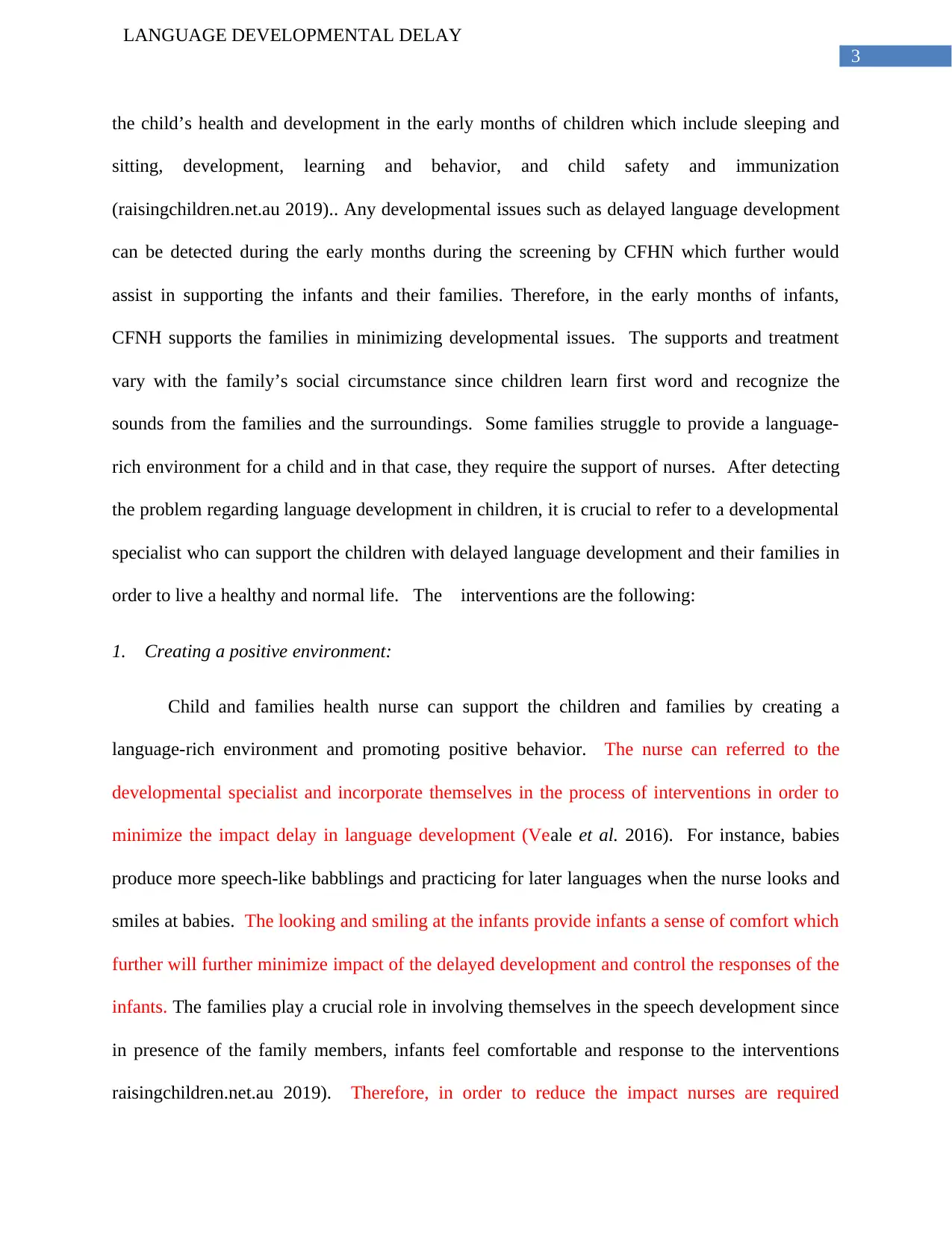
3
LANGUAGE DEVELOPMENTAL DELAY
the child’s health and development in the early months of children which include sleeping and
sitting, development, learning and behavior, and child safety and immunization
(raisingchildren.net.au 2019).. Any developmental issues such as delayed language development
can be detected during the early months during the screening by CFHN which further would
assist in supporting the infants and their families. Therefore, in the early months of infants,
CFNH supports the families in minimizing developmental issues. The supports and treatment
vary with the family’s social circumstance since children learn first word and recognize the
sounds from the families and the surroundings. Some families struggle to provide a language-
rich environment for a child and in that case, they require the support of nurses. After detecting
the problem regarding language development in children, it is crucial to refer to a developmental
specialist who can support the children with delayed language development and their families in
order to live a healthy and normal life. The interventions are the following:
1. Creating a positive environment:
Child and families health nurse can support the children and families by creating a
language-rich environment and promoting positive behavior. The nurse can referred to the
developmental specialist and incorporate themselves in the process of interventions in order to
minimize the impact delay in language development (Veale et al. 2016). For instance, babies
produce more speech-like babblings and practicing for later languages when the nurse looks and
smiles at babies. The looking and smiling at the infants provide infants a sense of comfort which
further will further minimize impact of the delayed development and control the responses of the
infants. The families play a crucial role in involving themselves in the speech development since
in presence of the family members, infants feel comfortable and response to the interventions
raisingchildren.net.au 2019). Therefore, in order to reduce the impact nurses are required
LANGUAGE DEVELOPMENTAL DELAY
the child’s health and development in the early months of children which include sleeping and
sitting, development, learning and behavior, and child safety and immunization
(raisingchildren.net.au 2019).. Any developmental issues such as delayed language development
can be detected during the early months during the screening by CFHN which further would
assist in supporting the infants and their families. Therefore, in the early months of infants,
CFNH supports the families in minimizing developmental issues. The supports and treatment
vary with the family’s social circumstance since children learn first word and recognize the
sounds from the families and the surroundings. Some families struggle to provide a language-
rich environment for a child and in that case, they require the support of nurses. After detecting
the problem regarding language development in children, it is crucial to refer to a developmental
specialist who can support the children with delayed language development and their families in
order to live a healthy and normal life. The interventions are the following:
1. Creating a positive environment:
Child and families health nurse can support the children and families by creating a
language-rich environment and promoting positive behavior. The nurse can referred to the
developmental specialist and incorporate themselves in the process of interventions in order to
minimize the impact delay in language development (Veale et al. 2016). For instance, babies
produce more speech-like babblings and practicing for later languages when the nurse looks and
smiles at babies. The looking and smiling at the infants provide infants a sense of comfort which
further will further minimize impact of the delayed development and control the responses of the
infants. The families play a crucial role in involving themselves in the speech development since
in presence of the family members, infants feel comfortable and response to the interventions
raisingchildren.net.au 2019). Therefore, in order to reduce the impact nurses are required
Paraphrase This Document
Need a fresh take? Get an instant paraphrase of this document with our AI Paraphraser

4
LANGUAGE DEVELOPMENTAL DELAY
incorporate family members and encourage them to use only positive words and languages to
minimize the impact .
2. Child-friendly interventions and giving the child the time to response:
The nurses collaborated with the specialist and family members can design interventions
which are child-friendly. For example, talking to the babies by showing pictures and books to
children are crucial for the caregivers so that they can learn from it. Using different words and
sentences with toddlers and waiting for the responses if delay observed may help the child in
learning the sounds of language and minimize the feeling of irritation, aggression which were
resulted from delayed language development (Wallac et al. 2018). It is crucial for the nurses to
spend more time with babies by telling stories, playing games involving languages to reduce the
impact of the delayed development.
3. Opportunities for a conversation:
The quality of the language children hear is crucial for faster language development and
inability to express themselves causes social isolation. In that case, relating new words to people
and places will help children to understand languages (Raisingchildren.net.au 2019). The nurses
are required to educate the parents regarding initiating the small conversations with the disable
child. The nurses can are read out books, showing simple objects and initiate small conversations
with the child which child can understand and guide infants in forming words slowly which
previously he or she had difficulty. Consequently, the child feel empowered and encouraged to
talk to others which further minimizing the impact of development.
LANGUAGE DEVELOPMENTAL DELAY
incorporate family members and encourage them to use only positive words and languages to
minimize the impact .
2. Child-friendly interventions and giving the child the time to response:
The nurses collaborated with the specialist and family members can design interventions
which are child-friendly. For example, talking to the babies by showing pictures and books to
children are crucial for the caregivers so that they can learn from it. Using different words and
sentences with toddlers and waiting for the responses if delay observed may help the child in
learning the sounds of language and minimize the feeling of irritation, aggression which were
resulted from delayed language development (Wallac et al. 2018). It is crucial for the nurses to
spend more time with babies by telling stories, playing games involving languages to reduce the
impact of the delayed development.
3. Opportunities for a conversation:
The quality of the language children hear is crucial for faster language development and
inability to express themselves causes social isolation. In that case, relating new words to people
and places will help children to understand languages (Raisingchildren.net.au 2019). The nurses
are required to educate the parents regarding initiating the small conversations with the disable
child. The nurses can are read out books, showing simple objects and initiate small conversations
with the child which child can understand and guide infants in forming words slowly which
previously he or she had difficulty. Consequently, the child feel empowered and encouraged to
talk to others which further minimizing the impact of development.
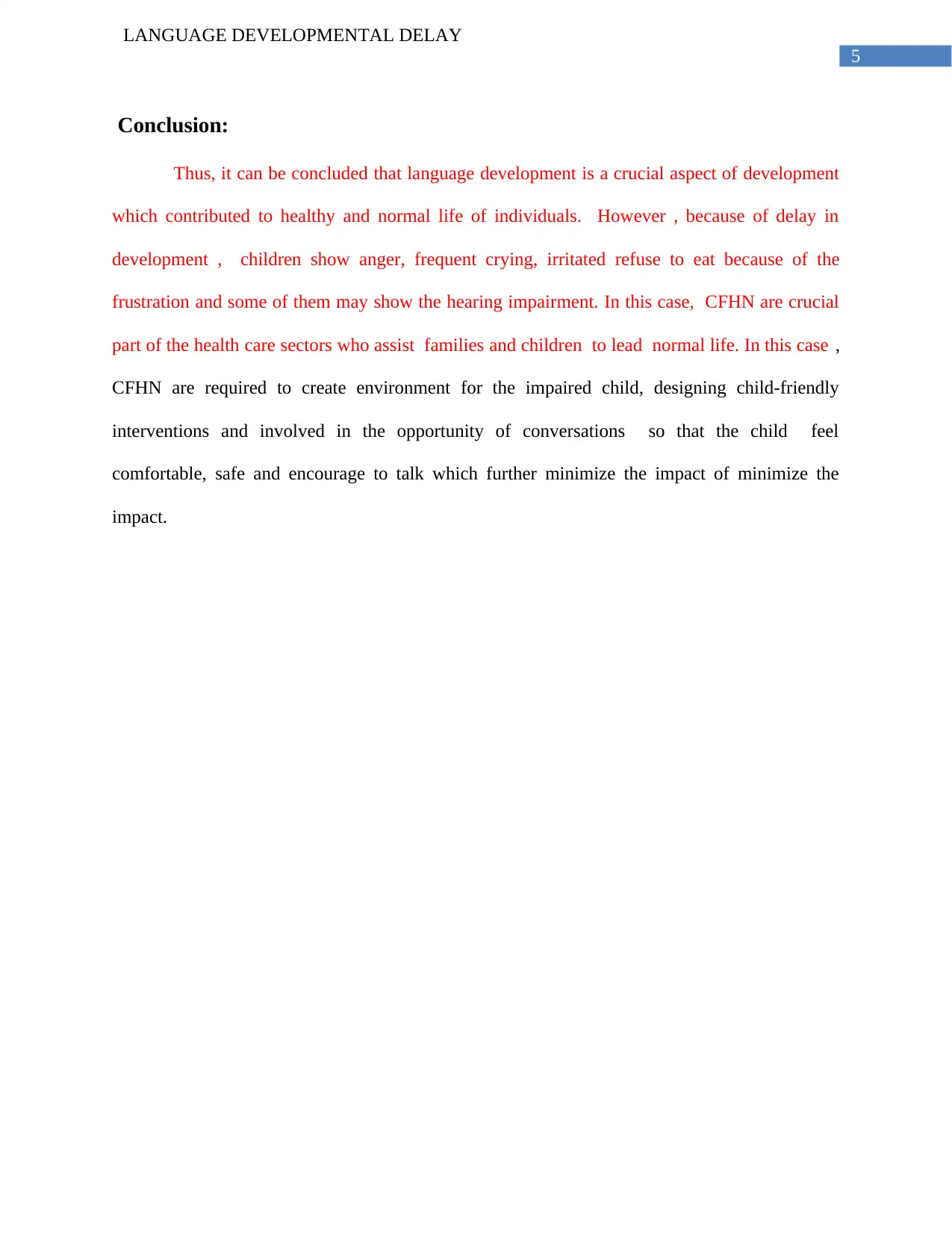
5
LANGUAGE DEVELOPMENTAL DELAY
Conclusion:
Thus, it can be concluded that language development is a crucial aspect of development
which contributed to healthy and normal life of individuals. However , because of delay in
development , children show anger, frequent crying, irritated refuse to eat because of the
frustration and some of them may show the hearing impairment. In this case, CFHN are crucial
part of the health care sectors who assist families and children to lead normal life. In this case ,
CFHN are required to create environment for the impaired child, designing child-friendly
interventions and involved in the opportunity of conversations so that the child feel
comfortable, safe and encourage to talk which further minimize the impact of minimize the
impact.
LANGUAGE DEVELOPMENTAL DELAY
Conclusion:
Thus, it can be concluded that language development is a crucial aspect of development
which contributed to healthy and normal life of individuals. However , because of delay in
development , children show anger, frequent crying, irritated refuse to eat because of the
frustration and some of them may show the hearing impairment. In this case, CFHN are crucial
part of the health care sectors who assist families and children to lead normal life. In this case ,
CFHN are required to create environment for the impaired child, designing child-friendly
interventions and involved in the opportunity of conversations so that the child feel
comfortable, safe and encourage to talk which further minimize the impact of minimize the
impact.
⊘ This is a preview!⊘
Do you want full access?
Subscribe today to unlock all pages.

Trusted by 1+ million students worldwide
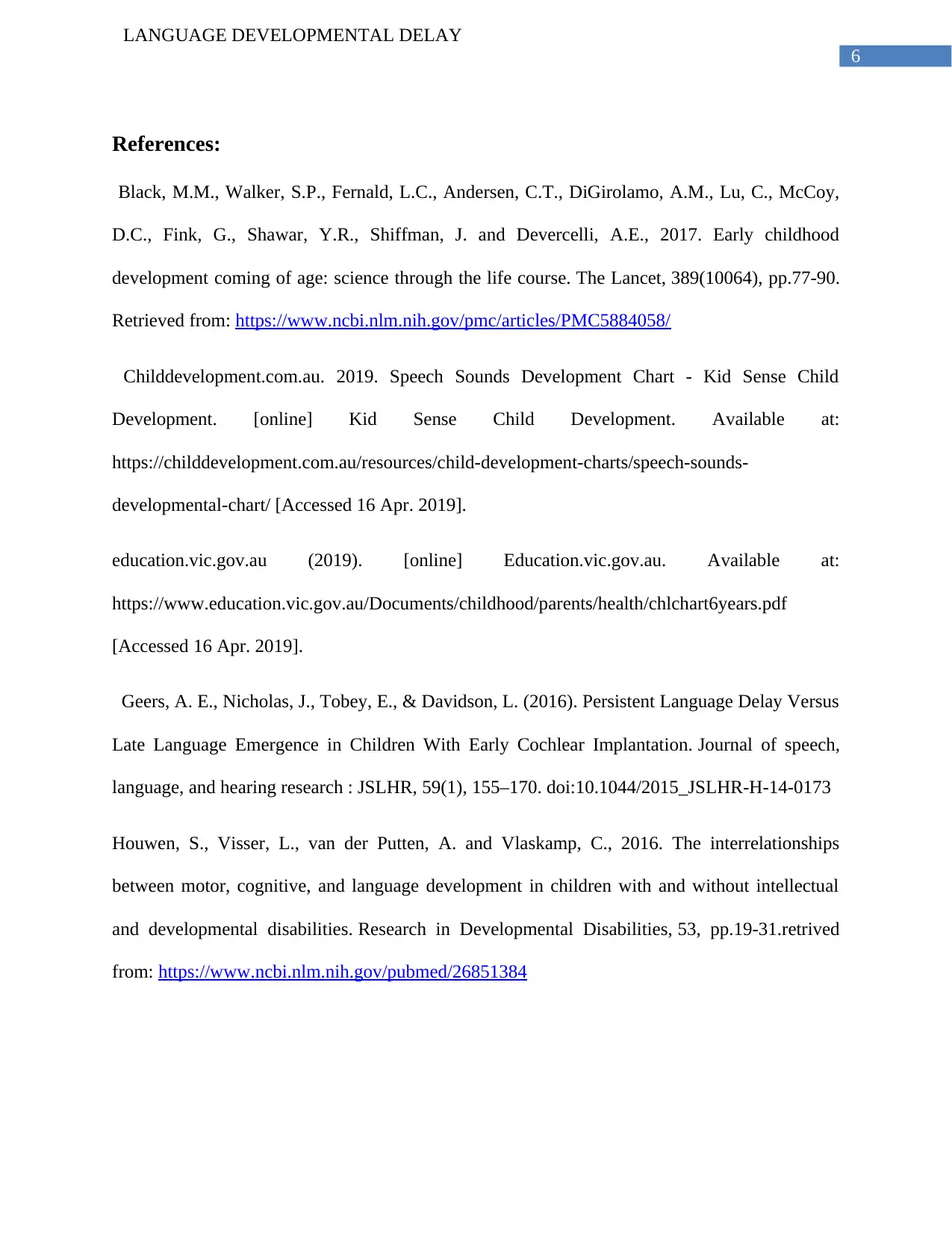
6
LANGUAGE DEVELOPMENTAL DELAY
References:
Black, M.M., Walker, S.P., Fernald, L.C., Andersen, C.T., DiGirolamo, A.M., Lu, C., McCoy,
D.C., Fink, G., Shawar, Y.R., Shiffman, J. and Devercelli, A.E., 2017. Early childhood
development coming of age: science through the life course. The Lancet, 389(10064), pp.77-90.
Retrieved from: https://www.ncbi.nlm.nih.gov/pmc/articles/PMC5884058/
Childdevelopment.com.au. 2019. Speech Sounds Development Chart - Kid Sense Child
Development. [online] Kid Sense Child Development. Available at:
https://childdevelopment.com.au/resources/child-development-charts/speech-sounds-
developmental-chart/ [Accessed 16 Apr. 2019].
education.vic.gov.au (2019). [online] Education.vic.gov.au. Available at:
https://www.education.vic.gov.au/Documents/childhood/parents/health/chlchart6years.pdf
[Accessed 16 Apr. 2019].
Geers, A. E., Nicholas, J., Tobey, E., & Davidson, L. (2016). Persistent Language Delay Versus
Late Language Emergence in Children With Early Cochlear Implantation. Journal of speech,
language, and hearing research : JSLHR, 59(1), 155–170. doi:10.1044/2015_JSLHR-H-14-0173
Houwen, S., Visser, L., van der Putten, A. and Vlaskamp, C., 2016. The interrelationships
between motor, cognitive, and language development in children with and without intellectual
and developmental disabilities. Research in Developmental Disabilities, 53, pp.19-31.retrived
from: https://www.ncbi.nlm.nih.gov/pubmed/26851384
LANGUAGE DEVELOPMENTAL DELAY
References:
Black, M.M., Walker, S.P., Fernald, L.C., Andersen, C.T., DiGirolamo, A.M., Lu, C., McCoy,
D.C., Fink, G., Shawar, Y.R., Shiffman, J. and Devercelli, A.E., 2017. Early childhood
development coming of age: science through the life course. The Lancet, 389(10064), pp.77-90.
Retrieved from: https://www.ncbi.nlm.nih.gov/pmc/articles/PMC5884058/
Childdevelopment.com.au. 2019. Speech Sounds Development Chart - Kid Sense Child
Development. [online] Kid Sense Child Development. Available at:
https://childdevelopment.com.au/resources/child-development-charts/speech-sounds-
developmental-chart/ [Accessed 16 Apr. 2019].
education.vic.gov.au (2019). [online] Education.vic.gov.au. Available at:
https://www.education.vic.gov.au/Documents/childhood/parents/health/chlchart6years.pdf
[Accessed 16 Apr. 2019].
Geers, A. E., Nicholas, J., Tobey, E., & Davidson, L. (2016). Persistent Language Delay Versus
Late Language Emergence in Children With Early Cochlear Implantation. Journal of speech,
language, and hearing research : JSLHR, 59(1), 155–170. doi:10.1044/2015_JSLHR-H-14-0173
Houwen, S., Visser, L., van der Putten, A. and Vlaskamp, C., 2016. The interrelationships
between motor, cognitive, and language development in children with and without intellectual
and developmental disabilities. Research in Developmental Disabilities, 53, pp.19-31.retrived
from: https://www.ncbi.nlm.nih.gov/pubmed/26851384
Paraphrase This Document
Need a fresh take? Get an instant paraphrase of this document with our AI Paraphraser
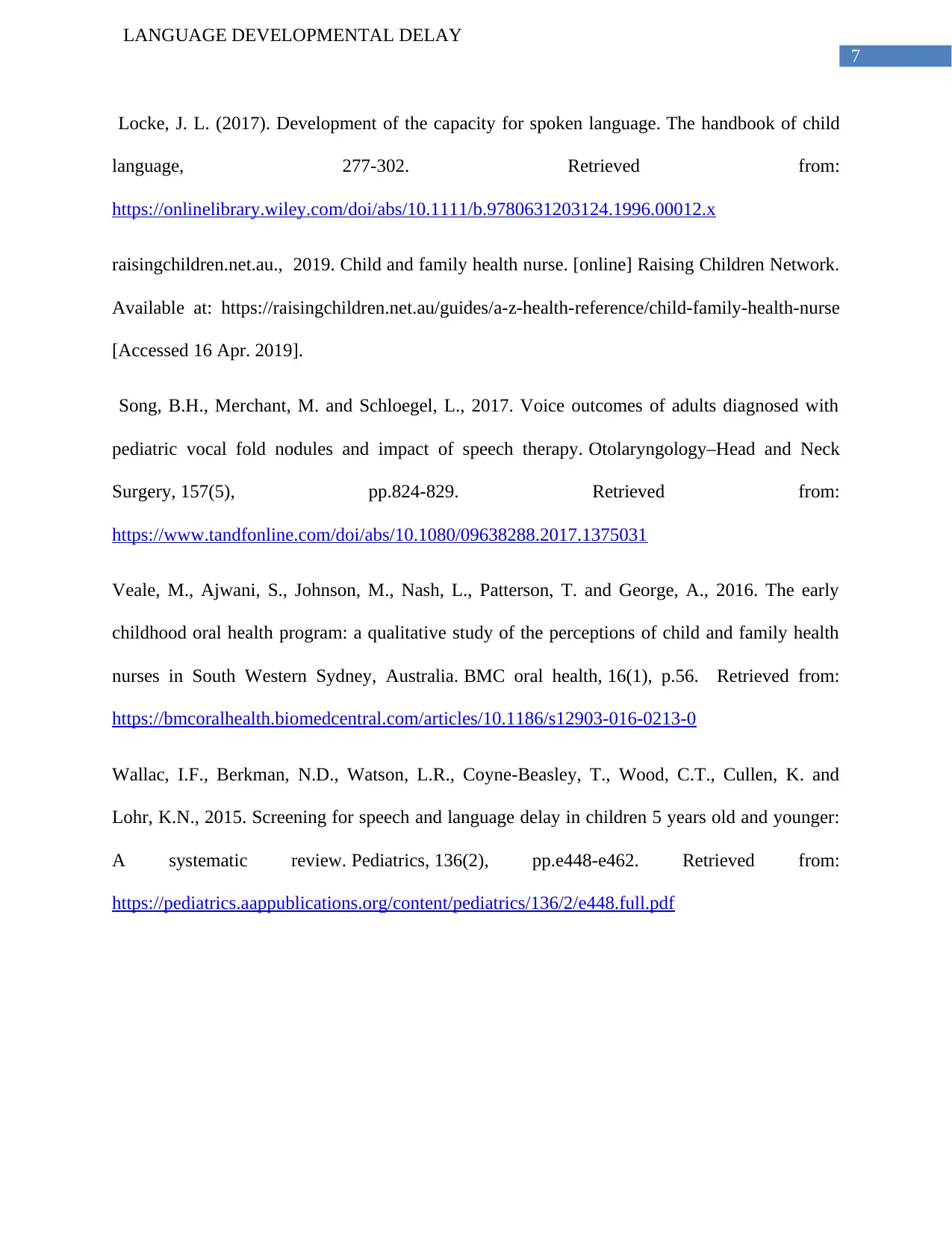
7
LANGUAGE DEVELOPMENTAL DELAY
Locke, J. L. (2017). Development of the capacity for spoken language. The handbook of child
language, 277-302. Retrieved from:
https://onlinelibrary.wiley.com/doi/abs/10.1111/b.9780631203124.1996.00012.x
raisingchildren.net.au., 2019. Child and family health nurse. [online] Raising Children Network.
Available at: https://raisingchildren.net.au/guides/a-z-health-reference/child-family-health-nurse
[Accessed 16 Apr. 2019].
Song, B.H., Merchant, M. and Schloegel, L., 2017. Voice outcomes of adults diagnosed with
pediatric vocal fold nodules and impact of speech therapy. Otolaryngology–Head and Neck
Surgery, 157(5), pp.824-829. Retrieved from:
https://www.tandfonline.com/doi/abs/10.1080/09638288.2017.1375031
Veale, M., Ajwani, S., Johnson, M., Nash, L., Patterson, T. and George, A., 2016. The early
childhood oral health program: a qualitative study of the perceptions of child and family health
nurses in South Western Sydney, Australia. BMC oral health, 16(1), p.56. Retrieved from:
https://bmcoralhealth.biomedcentral.com/articles/10.1186/s12903-016-0213-0
Wallac, I.F., Berkman, N.D., Watson, L.R., Coyne-Beasley, T., Wood, C.T., Cullen, K. and
Lohr, K.N., 2015. Screening for speech and language delay in children 5 years old and younger:
A systematic review. Pediatrics, 136(2), pp.e448-e462. Retrieved from:
https://pediatrics.aappublications.org/content/pediatrics/136/2/e448.full.pdf
LANGUAGE DEVELOPMENTAL DELAY
Locke, J. L. (2017). Development of the capacity for spoken language. The handbook of child
language, 277-302. Retrieved from:
https://onlinelibrary.wiley.com/doi/abs/10.1111/b.9780631203124.1996.00012.x
raisingchildren.net.au., 2019. Child and family health nurse. [online] Raising Children Network.
Available at: https://raisingchildren.net.au/guides/a-z-health-reference/child-family-health-nurse
[Accessed 16 Apr. 2019].
Song, B.H., Merchant, M. and Schloegel, L., 2017. Voice outcomes of adults diagnosed with
pediatric vocal fold nodules and impact of speech therapy. Otolaryngology–Head and Neck
Surgery, 157(5), pp.824-829. Retrieved from:
https://www.tandfonline.com/doi/abs/10.1080/09638288.2017.1375031
Veale, M., Ajwani, S., Johnson, M., Nash, L., Patterson, T. and George, A., 2016. The early
childhood oral health program: a qualitative study of the perceptions of child and family health
nurses in South Western Sydney, Australia. BMC oral health, 16(1), p.56. Retrieved from:
https://bmcoralhealth.biomedcentral.com/articles/10.1186/s12903-016-0213-0
Wallac, I.F., Berkman, N.D., Watson, L.R., Coyne-Beasley, T., Wood, C.T., Cullen, K. and
Lohr, K.N., 2015. Screening for speech and language delay in children 5 years old and younger:
A systematic review. Pediatrics, 136(2), pp.e448-e462. Retrieved from:
https://pediatrics.aappublications.org/content/pediatrics/136/2/e448.full.pdf
1 out of 8
Related Documents
Your All-in-One AI-Powered Toolkit for Academic Success.
+13062052269
info@desklib.com
Available 24*7 on WhatsApp / Email
![[object Object]](/_next/static/media/star-bottom.7253800d.svg)
Unlock your academic potential
Copyright © 2020–2025 A2Z Services. All Rights Reserved. Developed and managed by ZUCOL.





